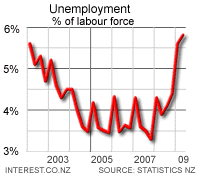 Unemployment rose to a seasonally adjusted 4.2% in the September quarter, but this was less than the 4.3% the market had expected and employment actually grew 0.13% or 3,000 during the quarter, which was much better than market expectations for a 0.6% fall in employment.
The New Zealand dollar initially blipped up to almost 60 USc from 59.7 USc on the data, indicating investors thought the chances of a big cut in the Official Cash Rate on December 4 had been diminised somewhat.
The figures appear to show employers are continuing to hoard workers and that either the employment market is not as bad as some had predicted or there is a very long lag between the economy going into recession in the March quarter and job losses.
The labour force participation rate was basically steady at 68.7%, which was better than the fall that many expect in a recession.
Here's the Statistics NZ summary below.
Unemployment rose to a seasonally adjusted 4.2% in the September quarter, but this was less than the 4.3% the market had expected and employment actually grew 0.13% or 3,000 during the quarter, which was much better than market expectations for a 0.6% fall in employment.
The New Zealand dollar initially blipped up to almost 60 USc from 59.7 USc on the data, indicating investors thought the chances of a big cut in the Official Cash Rate on December 4 had been diminised somewhat.
The figures appear to show employers are continuing to hoard workers and that either the employment market is not as bad as some had predicted or there is a very long lag between the economy going into recession in the March quarter and job losses.
The labour force participation rate was basically steady at 68.7%, which was better than the fall that many expect in a recession.
Here's the Statistics NZ summary below.
The September 2008 quarter Household Labour Force Survey (HLFS) showed an increase in the unemployment rate, and a record-equalling labour force participation rate. The number of people employed also rose, albeit modestly. Over the quarter, the total labour force grew at a faster rate than the number of people employed, resulting in an increase in the unemployment rate of 0.3 percentage points, to 4.2 percent. The labour force participation rate increased to 68.7 percent, the equal-highest level ever recorded by the HLFS. The female labour force participation rate of 62.6 percent was a record high, while the male labour force participation rate fell to 75.0 percent. Employment increased over the quarter by 3,000 (0.1 percent), following an increase of 27,000 (1.2 percent) in the June 2008 quarter. Male employment fell by 5,000 (0.4 percent). Female employment rose by 8,000 (0.8 percent). In summary, the September quarter has seen a further increase in the unemployment rate and a slowing of employment growth. The unemployment rate is now above 4.0 percent for the first time since June 2004.What I think it means This suggests the economy (or at least the labour market) is not slowing as much or as fast as some feared. The fact that the participation rate was at a record high and that employment actually grew was a real surprise. Participation tends to fall during a slowdown. I suspect many employers are hoarding workers as much as possible, given their recent experience of labour shortages. This may well extend the lag between the slowing economy and a weaker jobs market. These figures may cause the Reserve Bank to be a little more cautious with the size of its expected rate cut on December 4. Most economists expect a 50 basis point cut to 6% on December 4. Some might have expected the RBNZ to match the Reserve Bank of Australia with a 75 basis point cut. My guess is this figure tips the balance back to a 50 basis point cut rather than 75 basis points. What does that mean for borrowers and investors? Investors should continue to try to lock in higher term deposit rates for as long as possible before they fall much further and the guaranteed finance company debenture rate are starting to look mighty attractive. See all the rates up to 1 year here and all the rates beyond 1 year here. Mortgage borrowers will see the best deals around at the moment in the 1 year range, which would be a sensible option given there's a chance variable rates will be lower than fixed rates within the next year. A two year fixed rate mortgage may not be the best bet giving falling interest rates. See all the mortgage rates here. What's your view? Comments below please.

We welcome your comments below. If you are not already registered, please register to comment
Remember we welcome robust, respectful and insightful debate. We don't welcome abusive or defamatory comments and will de-register those repeatedly making such comments. Our current comment policy is here.